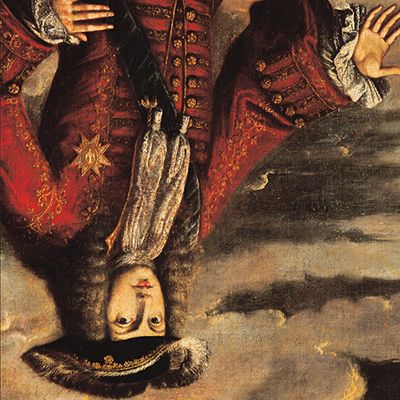Timeline
The Montsant Hotel’s location on the way to the castle has given the building a privileged role in the history of Xàtiva over the centuries.
In ancient times
Visigoth domination
Moorish era
The royal palace
The convent
The Borgias
Philip V
Military occupation and seizure
Country house
The hotel
In ancient times
The first signs of urban habitation in what is now the town of Xàtiva date from the Bronze Age (800-700 BC).The town of Saetabi was the site of coin mint during the Iberian era, and attained great strategic and commercial importance.Under the Romans, the place now known as Sætabis was an imperial town renowned for its linen textiles, as mentioned by the writer Catullus in his poems.

Visigoth domination

The town was raised to a bishopric in this period. The Visigoth cathedral stood on the site now occupied by the chapel of St Felix. Written records of the Councils of Toledo indicate the presence of various bishops from Xàtiva. The municipal museum possesses a Romano-Christian altar, inscribed to record it being consecrated by Bishop Athanasius, and a cross with a relief depicting the Lamb of God.
Moorish era
Xàtiva was a major town of Al-Ándalus during the Moorish period (800-1300 AD). Large parts of the surviving town walls date from this time. As the Caliphate was coming to an end, a writer from Córdoba called Ibn Hazam took refuge in the town, where he wrote his work entitled The Ring of the Dove:a treatise on the art and practice of love. What we now know as the Montsant Hotel was then a complex of buildings and gardens that served as the town’s centre of political power.

The royal palace

When King James I of Aragon conquered Xàtiva in the 13th century, the Montsant became the town’s royal palace, both for James himself and for his successors Peter II, Alphonse II and James II. It also served for several years as the palatine residence of the exiled Princess Eudoxia Laskarina of Byzantium. The large Aljibe reservoir, which was built during this first Christian period, still survives.
The convent
James II founded the Cistercian Convent of Montsant early in the 14th century.The church was built, along with the cloister, the chapter room and various secondary structures.The 16th century saw a series of major additions in the Renaissance style.The nuns were expelled after the Council of Trent, and the convent was occupied by monks from the nearby Cistercian Monastery of Valldigna.

The Borgias

The late-mediaeval period from 1400 onwards was the golden age of the Kingdom of Valenciain commercial, artistic, literary and also ecclesiastical terms, as members of a Xàtiva family named Borja – subsequently immortalised as the Borgias – occupied the papacy on two occasions in the shape ofCallixtus III and Alexander VI. Alexander purchased the Duchy of Gandía from the Crown for his children, of a family that was soon to produce a third major historical figure: Saint Francis Borgia, also known as San Francisco de Borja.
Philip V
When Charles II of Spain died in 1700 without an heir, the Kingdom of Valencia became involved in what was to become known as the War of the Spanish Succession; a conflict that was to draw in various European powers. Aragon, England, the Dutch Republic, Austria and Portugal supported the claim of Charles of Austria,while Castile and France sided with Philip of Anjou. The Battle of Almansa in 1707 marked the defeat of Charles in Valencia. As a punishment, Xàtiva was besieged, attacked, sacked and burnt down by troops of Philip V, who would go on to rename the town “New Colony of Saint Philip”. The Kingdom of Valencia was also deprived of its parliament, its laws, its coinage and the official use of its language. The official portrait of Philip V that once graced the main room of the town hall is now displayed upside down in the municipal museum.It has hung there since the 1950s in symbolic revenge for the burning of the town.

Military occupation and seizure

The Monastery of Montsant was occupied by military forces in both the War of the Spanish Succession and the Napoleonic wars. The Spanish state partially requisitioned the building in 1820, and a minister named Mendizábal made the transfer of title permanent in 1835. The monastery then became a widows’ asylum and poorhouse, before being sold in 1855 to a private buyer, who demolished the church and the cloister.
Country house
After the “Mendizábal confiscation”, Montsant became a private residence. The monastery was demolished to provide construction materials, and the outside walls were incorporated into a new country house. The house continued to be a private residence for more than a century, under the ownership of the grandfather of Alcoy-born author Juan Gil-Albert, who spent his childhood summers at the house. The current layout of the gardens dates from this time.

The hotel

The Montsant Hotel first opened its doors in 1994. It was acquired in 2009 by INELCOM S.A., a Xátiva-based business dedicated to the design and manufacture of electronic equipment and energy-efficiency devices.
In ancient times
The first signs of urban habitation in what is now the town of Xàtiva date from the Bronze Age (800-700 BC).The town of Saetabi was the site of coin mint during the Iberian era, and attained great strategic and commercial importance.Under the Romans, the place now known as Sætabis was an imperial town renowned for its linen textiles, as mentioned by the writer Catullus in his poems. 
Visigoth domination 
The town was raised to a bishopric in this period. The Visigoth cathedral stood on the site now occupied by the chapel of St Felix. Written records of the Councils of Toledo indicate the presence of various bishops from Xàtiva. The municipal museum possesses a Romano-Christian altar, inscribed to record it being consecrated by Bishop Athanasius, and a cross with a relief depicting the Lamb of God.
Moorish era
Xàtiva was a major town of Al-Ándalus during the Moorish period (800-1300 AD). Large parts of the surviving town walls date from this time. As the Caliphate was coming to an end, a writer from Córdoba called Ibn Hazam took refuge in the town, where he wrote his work entitled The Ring of the Dove:a treatise on the art and practice of love. What we now know as the Montsant Hotel was then a complex of buildings and gardens that served as the town’s centre of political power.
The royal palace 
When King James I of Aragon conquered Xàtiva in the 13th century, the Montsant became the town’s royal palace, both for James himself and for his successors Peter II, Alphonse II and James II. It also served for several years as the palatine residence of the exiled Princess Eudoxia Laskarina of Byzantium. The large Aljibe reservoir, which was built during this first Christian period, still survives.
The convent
James II founded the Cistercian Convent of Montsant early in the 14th century.The church was built, along with the cloister, the chapter room and various secondary structures.The 16th century saw a series of major additions in the Renaissance style.The nuns were expelled after the Council of Trent, and the convent was occupied by monks from the nearby Cistercian Monastery of Valldigna.
The Borgias
The late-mediaeval period from 1400 onwards was the golden age of the Kingdom of Valenciain commercial, artistic, literary and also ecclesiastical terms, as members of a Xàtiva family named Borja – subsequently immortalised as the Borgias – occupied the papacy on two occasions in the shape ofCallixtus III and Alexander VI. Alexander purchased the Duchy of Gandía from the Crown for his children, of a family that was soon to produce a third major historical figure: Saint Francis Borgia, also known as San Francisco de Borja.
Philip V
When Charles II of Spain died in 1700 without an heir, the Kingdom of Valencia became involved in what was to become known as the War of the Spanish Succession; a conflict that was to draw in various European powers. Aragon, England, the Dutch Republic, Austria and Portugal supported the claim of Charles of Austria,while Castile and France sided with Philip of Anjou. The Battle of Almansa in 1707 marked the defeat of Charles in Valencia. As a punishment, Xàtiva was besieged, attacked, sacked and burnt down by troops of Philip V, who would go on to rename the town “New Colony of Saint Philip”. The Kingdom of Valencia was also deprived of its parliament, its laws, its coinage and the official use of its language. The official portrait of Philip V that once graced the main room of the town hall is now displayed upside down in the municipal museum.It has hung there since the 1950s in symbolic revenge for the burning of the town. 
Military occupation and seizure
The Monastery of Montsant was occupied by military forces in both the War of the Spanish Succession and the Napoleonic wars. The Spanish state partially requisitioned the building in 1820, and a minister named Mendizábal made the transfer of title permanent in 1835. The monastery then became a widows’ asylum and poorhouse, before being sold in 1855 to a private buyer, who demolished the church and the cloister.
Country house
After the “Mendizábal confiscation”, Montsant became a private residence. The monastery was demolished to provide construction materials, and the outside walls were incorporated into a new country house. The house continued to be a private residence for more than a century, under the ownership of the grandfather of Alcoy-born author Juan Gil-Albert, who spent his childhood summers at the house. The current layout of the gardens dates from this time.
The hotel 
The Montsant Hotel first opened its doors in 1994. It was acquired in 2009 by INELCOM S.A., a Xátiva-based business dedicated to the design and manufacture of electronic equipment and energy-efficiency devices.
